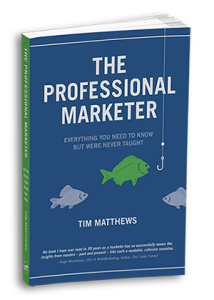Estimated Reading Time: 1 minute
Marketingspeak is my occasional series on interesting words I encounter in my day job in marketing. I do my best to channel the late great William Saphire, whose ‘On Language’ column brought a smile to my face many a Sunday. – TM
 Greeking is a typesetting technique where intentionally incomprehensible dummy text is used to test the layout of a document. Since the reader can’t understand the text, they focus on the layout, which is the point. Plus, the designer doesn’t have to wait for the content to be finished to start working. The term was derived from the common idiom “It’s Greek to me,” itself from Shakespeare’s Julius Caesar.
Greeking is a typesetting technique where intentionally incomprehensible dummy text is used to test the layout of a document. Since the reader can’t understand the text, they focus on the layout, which is the point. Plus, the designer doesn’t have to wait for the content to be finished to start working. The term was derived from the common idiom “It’s Greek to me,” itself from Shakespeare’s Julius Caesar.
If you work in marketing, you have probably seen the words “Lorem ipsum dolor” when reviewing a new document or website design. These words are the most commonly used for greeking, and are a scrambled version of the Roman philosopher Cicero’s “The Extremes of Good and Evil.” In case you’ve forgotten it from high school Latin class, here’s the text:
Lorem ipsum dolor sit amet, consectetur adipiscing elit, sed do eiusmod tempor incididunt ut labore et dolore magna aliqua. Ut enim ad minim veniam, quis nostrud exercitation ullamco laboris nisi ut aliquip ex ea commodo consequat. Duis aute irure dolor in reprehenderit in voluptate velit esse cillum dolore eu fugiat nulla pariatur. Excepteur sint occaecat cupidatat non proident, sunt in culpa qui officia deserunt mollit anim id est laborum.
So yes, the most common form of Greeking is in Latin. But remember, the term means “make incomprehensible,” not “write it in Greek.” Using the Greek alphabet would likely be distracting to the document reviewer, which is what greeking sets out to avoid in the first place. Latin, on the other hand, uses the same Roman alphabet as English. As a dead language it is the least likely to be understood by the modern reader. (What’s used in Greece, Russia, Japan, China and other countries that don’t use the Roman alphabet I don’t know.)
Who invented the technique? No one knows the name of the printer himself, but the scrambled version of Cicero’s writing first appeared in a print specimen book in the 1500’s. It was popularized in the 1960’s by the British typeface company Letraset. Aldus, creators of PageMaker (now owned by Adobe), are credited with bringing the text online.
So, the technique came to us from an anonymous printer living during the Renaissance, using the writing of an ancient Roman philosopher, and termed in a nod to the most famous playwright of all time. Never has so much history been packed into a single paragraph we ultimately ignore.
 Want to learn even more about marketing?
Want to learn even more about marketing?